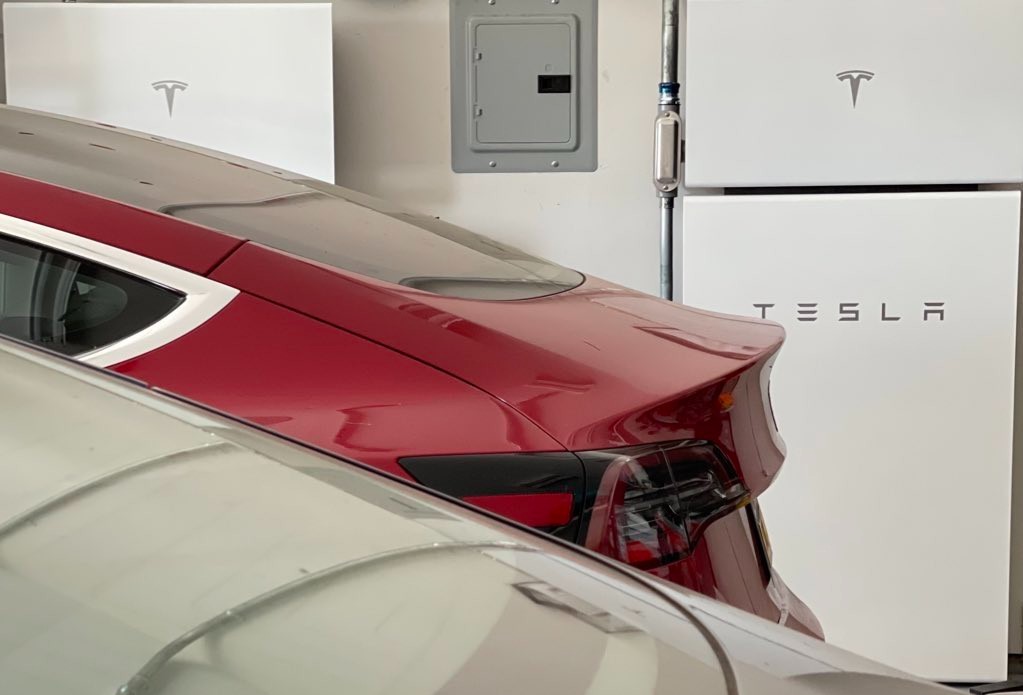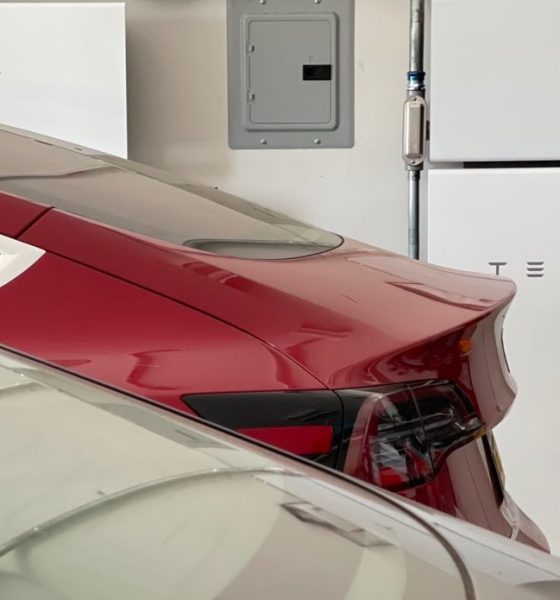

News
Tesla Solar + Powerwall more than covers monthly payment after a week of VPP events
Tesla owner Mark Gillund of Sacramento, California, will not be paying out of pocket for his solar and battery system’s monthly payment this month. This was because his home is part of Tesla’s California Virtual Power Plant (VPP), which has been providing backup power to the grid as the state continues to deal with challenges brought about by the recent heatwave.
Mark Gillund placed his order for a Tesla Solar + Powerwall system in June last year. By the second week of August 2021, his solar panels and batteries were installed, though the homeowner had to wait until early September 2021 before the system was actually turned on. The setup was quite impressive, with its 12.24 kWh solar array, three Tesla Powerwall batteries, and two inverters. This, Gillund believed, would be a good way to reduce his home’s typical power bill, which hits about $650 per month during summer.
The benefits of the solar panels and Powerwall batteries were immediately evident, with the Tesla owner noting that his home’s power charges dropped to just the $10 minimum every month. Thus, when Tesla launched its California Virtual Power Plant, the Powerwall owner promptly opted in. With the rollout of the program’s $2 per kWh incentive, joining the California VPP made even more sense.
With California dealing with a serious heatwave, the state’s grid has seen its own fair share of challenges as of late. Tesla’s California Virtual Power Plant promptly went to work, providing the grid with backup renewable energy as needed. Lastbulb’s VPP tracker suggests that there are now over 4,600 homes that are participating in the California Virtual Power Plant, and so far, the system has provided about 577 MWh of energy to the state’s grid.
Gillund’s Tesla Solar + Powerwall system participated in the recent VPP events, sending 35 kWh back to the grid during the September 9 event alone. Overall, the homeowner’s solar and battery system had sent a total of 255 kWh during the ongoing heat wave. This meant that the system had been able to earn $510 in compensation with just a week’s worth of VPP events. This was more than enough to cover the monthly payment of Gillund’s entire solar and battery system.
As mentioned by Gillund to Teslarati, the monthly fee for his Powerwall and solar loan is $400. This meant that as long as his home sends over 200 kWh of power to the grid, the system could effectively pay for itself. In a way, this is pretty much the cherry on top for the homeowner, as his Powerwall and solar system had actually been cash positive so far.
Gillund was fortunate enough to receive a $14,000 tax credit for his solar and batteries, so he’s still paying for the system’s monthly fees with that amount. The earnings of the system through his home’s participation in the California Virtual Power Plant could then be considered an extremely welcome extra. It could also be proof that Tesla CEO Elon Musk was really onto something when he noted that renewable energy solutions could effectively become a money printer of sorts.
Check out Gillund’s insights on the CA VPP in the video below.
Don’t hesitate to contact us with news tips. Just send a message to simon@teslarati.com to give us a heads up.

News
Tesla starts showing how FSD will change lives in Europe
Local officials tested the system on narrow country roads and were impressed by FSD’s smooth, human-like driving, with some calling the service a game-changer for everyday life in areas that are far from urban centers.

Tesla has launched Europe’s first public shuttle service using Full Self-Driving (Supervised) in the rural Eifelkreis Bitburg-Prüm region of Germany, demonstrating how the technology can restore independence and mobility for people who struggle with limited transport options.
Local officials tested the system on narrow country roads and were impressed by FSD’s smooth, human-like driving, with some calling the service a game-changer for everyday life in areas that are far from urban centers.
Officials see real impact on rural residents
Arzfeld Mayor Johannes Kuhl and District Administrator Andreas Kruppert personally tested the Tesla shuttle service. This allowed them to see just how well FSD navigated winding lanes and rural roads confidently. Kruppert said, “Autonomous driving sounds like science fiction to many, but we simply see here that it works totally well in rural regions too.” Kuhl, for his part, also noted that FSD “feels like a very experienced driver.”
The pilot complements the area’s “Citizen Bus” program, which provides on-demand rides for elderly residents who can no longer drive themselves. Tesla Europe shared a video of a demonstration of the service, highlighting how FSD gives people their freedom back, even in places where public transport is not as prevalent.
What the Ministry for Economic Affairs and Transport says
Rhineland-Palatinate’s Minister Daniela Schmitt supported the project, praising the collaboration that made this “first of its kind in Europe” possible. As per the ministry, the rural rollout for the service shows FSD’s potential beyond major cities, and it delivers tangible benefits like grocery runs, doctor visits, and social connections for isolated residents.
“Reliable and flexible mobility is especially vital in rural areas. With the launch of a shuttle service using self-driving vehicles (FSD supervised) by Tesla in the Eifelkreis Bitburg-Prüm, an innovative pilot project is now getting underway that complements local community bus services. It is the first project of its kind in Europe.
“The result is a real gain for rural mobility: greater accessibility, more flexibility and tangible benefits for everyday life. A strong signal for innovation, cooperation and future-oriented mobility beyond urban centers,” the ministry wrote in a LinkedIn post.
News
Tesla China quietly posts Robotaxi-related job listing
Tesla China is currently seeking a Low Voltage Electrical Engineer to work on circuit board design for the company’s autonomous vehicles.

Tesla has posted a new job listing in Shanghai explicitly tied to its Robotaxi program, fueling speculation that the company is preparing to launch its dedicated autonomous ride-hailing service in China.
As noted in the listing, Tesla China is currently seeking a Low Voltage Electrical Engineer to work on circuit board design for the company’s autonomous vehicles.
Robotaxi-specific role
The listing, which was shared on social media platform X by industry watcher @tslaming, suggested that Tesla China is looking to fill the role urgently. The job listing itself specifically mentions that the person hired for the role will be working on the Low Voltage Hardware team, which would design the circuit boards that would serve as the nervous system of the Robotaxi.
Key tasks for the role, as indicated in the job listing, include collaboration with PCB layout, firmware, mechanical, program management, and validation teams, among other responsibilities. The role is based in Shanghai.
China Robotaxi launch
China represents a massive potential market for robotaxis, with its dense urban centers and supportive policies in select cities. Tesla has limited permission to roll out FSD in the country, though despite this, its vehicles have been hailed as among the best in the market when it comes to autonomous features. So far, at least, it appears that China supports Tesla’s FSD and Robotaxi rollout.
This was hinted at in November, when Tesla brought the Cybercab to the 8th China International Import Expo (CIIE) in Shanghai, marking the first time that the autonomous two-seater was brought to the Asia-Pacific region. The vehicle, despite not having a release date in China, received a significant amount of interest among the event’s attendees.
Elon Musk
Elon Musk and Tesla AI Director share insights after empty driver seat Robotaxi rides
The executives’ unoccupied tests hint at the rapid progress of Tesla’s unsupervised Robotaxi efforts.

Tesla CEO Elon Musk and AI Director Ashok Elluswamy celebrated Christmas Eve by sharing personal experiences with Robotaxi vehicles that had no safety monitor or occupant in the driver’s seat. Musk described the system’s “perfect driving” around Austin, while Elluswamy posted video from the back seat, calling it “an amazing experience.”
The executives’ unoccupied tests hint at the rapid progress of Tesla’s unsupervised Robotaxi efforts.
Elon and Ashok’s firsthand Robotaxi insights
Prior to Musk and the Tesla AI Director’s posts, sightings of unmanned Teslas navigating public roads were widely shared on social media. One such vehicle was spotted in Austin, Texas, which Elon Musk acknowleged by stating that “Testing is underway with no occupants in the car.”
Based on his Christmas Eve post, Musk seemed to have tested an unmanned Tesla himself. “A Tesla with no safety monitor in the car and me sitting in the passenger seat took me all around Austin on Sunday with perfect driving,” Musk wrote in his post.
Elluswamy responded with a 2-minute video showing himself in the rear of an unmanned Tesla. The video featured the vehicle’s empty front seats, as well as its smooth handling through real-world traffic. He captioned his video with the words, “It’s an amazing experience!”
Towards Unsupervised operations
During an xAI Hackathon earlier this month, Elon Musk mentioned that Tesla owed be removing Safety Monitors from its Robotaxis in Austin in just three weeks. “Unsupervised is pretty much solved at this point. So there will be Tesla Robotaxis operating in Austin with no one in them. Not even anyone in the passenger seat in about three weeks,” he said. Musk echoed similar estimates at the 2025 Annual Shareholder Meeting and the Q3 2025 earnings call.
Considering the insights that were posted Musk and Elluswamy, it does appear that Tesla is working hard towards operating its Robotaxis with no safety monitors. This is quite impressive considering that the service was launched just earlier this year.








